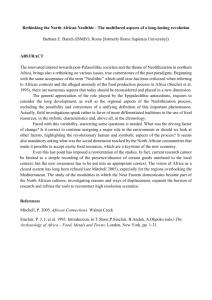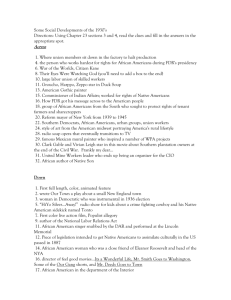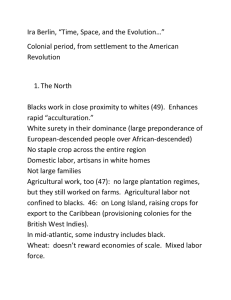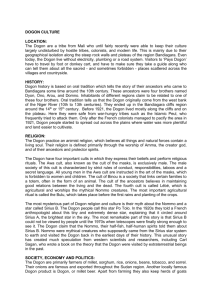Intro to African Art
advertisement
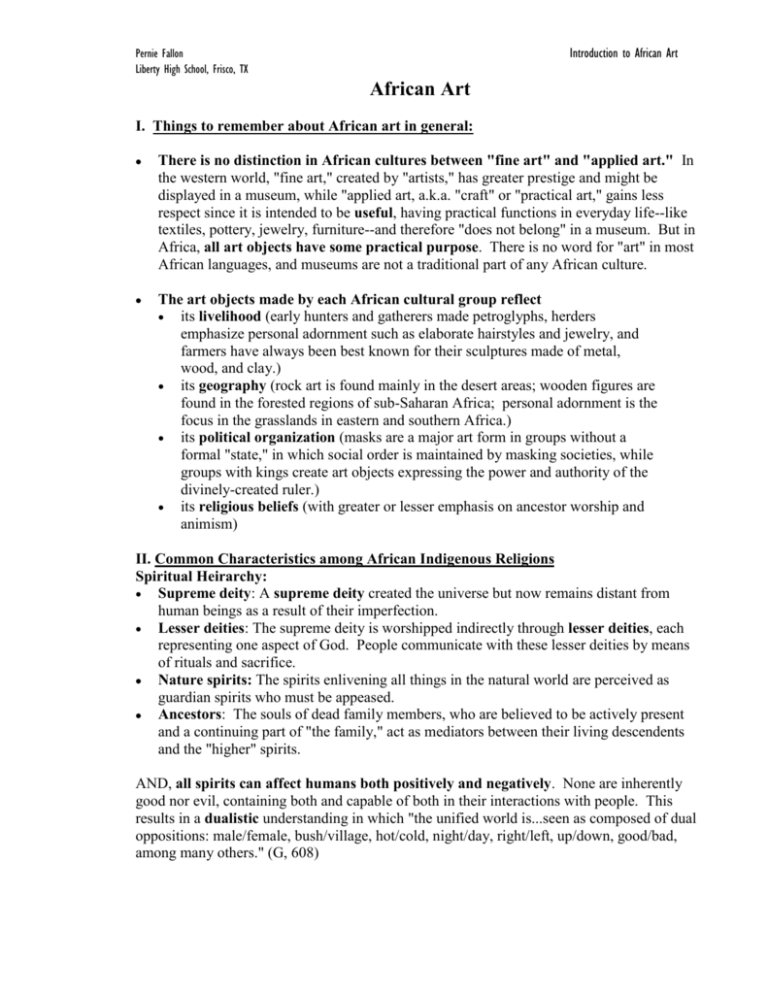
Introduction to African Art Pernie Fallon Liberty High School, Frisco, TX African Art I. Things to remember about African art in general: There is no distinction in African cultures between "fine art" and "applied art." In the western world, "fine art," created by "artists," has greater prestige and might be displayed in a museum, while "applied art, a.k.a. "craft" or "practical art," gains less respect since it is intended to be useful, having practical functions in everyday life--like textiles, pottery, jewelry, furniture--and therefore "does not belong" in a museum. But in Africa, all art objects have some practical purpose. There is no word for "art" in most African languages, and museums are not a traditional part of any African culture. The art objects made by each African cultural group reflect its livelihood (early hunters and gatherers made petroglyphs, herders emphasize personal adornment such as elaborate hairstyles and jewelry, and farmers have always been best known for their sculptures made of metal, wood, and clay.) its geography (rock art is found mainly in the desert areas; wooden figures are found in the forested regions of sub-Saharan Africa; personal adornment is the focus in the grasslands in eastern and southern Africa.) its political organization (masks are a major art form in groups without a formal "state," in which social order is maintained by masking societies, while groups with kings create art objects expressing the power and authority of the divinely-created ruler.) its religious beliefs (with greater or lesser emphasis on ancestor worship and animism) II. Common Characteristics among African Indigenous Religions Spiritual Heirarchy: Supreme deity: A supreme deity created the universe but now remains distant from human beings as a result of their imperfection. Lesser deities: The supreme deity is worshipped indirectly through lesser deities, each representing one aspect of God. People communicate with these lesser deities by means of rituals and sacrifice. Nature spirits: The spirits enlivening all things in the natural world are perceived as guardian spirits who must be appeased. Ancestors: The souls of dead family members, who are believed to be actively present and a continuing part of "the family," act as mediators between their living descendents and the "higher" spirits. AND, all spirits can affect humans both positively and negatively. None are inherently good nor evil, containing both and capable of both in their interactions with people. This results in a dualistic understanding in which "the unified world is...seen as composed of dual oppositions: male/female, bush/village, hot/cold, night/day, right/left, up/down, good/bad, among many others." (G, 608) Pernie Fallon Liberty High School, Frisco, TX Introduction to African Art III. General Characteristics of Sub-Saharan African Sculpture: combination of abstraction and naturalism called jijora, "a moderate resemblance to the subject, something between absolute abstraction and absolute likeness" (HF, 705) "Since a spirit, not a person, is being evoked, naturalism of form, texture, and color are not prerequisites. We have here the principle of abstraction used for the representation of a being not of the natural world." (Witt, I, 433) "African arts portray an ideal of resemblance rather than identity. Sculptors in particular, seek to represent a moral or spiritual force rather than to make an individual portrait....it Example of jijora in Frank Willett’s African Art. is never totally realistic or totally nonfigurative, but rather seeks a balance somewhere between the two poles." (Witt, 450) symmetry around a vertical axis curving, tubular, cylindrical, columnar, polar forms, often carved from a single piece of wood. The curving lines express the energy found in all nature. frontality static poses (lack of any movement) 'coolness' of facial expression use of negative (empty) space is just as important as the use of positive (filled) space (similar to the importance of the moments of silence between the rhythmic beats on a drum) The negative spaces, like the silence between the beats, are not passive but active parts of the rhythmic flow. human figures generally show odo, youthfulness, the prime of life the physical proportions of a figure reflecting the culture's ideas of what defines a person, such as an enlarged head or hands or naval, rather than Dogon Primordial Couple, natural proportions Metropolitan Museum, NY IV: Four Kinds of Sculptures (created from clay, metals, and wood): Figures: 3 kinds (see below) Masks: 3 kinds (see below) Ceremonial items--jewelry, decorative weapons, items representing kingship Household items--stools, other furniture Figures: 3 kinds Ancestor, done out of both respect for their deceased ancestors and out of fear of their angry spirits. Ancestor figures are "created as pleasant resting places for spirits. These sculptures were not created to symbolize a spirit; they were created to contain the spirit of the deceased person." (M, 273) Types include: o primordial ancestors o royal ancestors/divine kings o maternity figures Introduction to African Art Pernie Fallon Liberty High School, Frisco, TX o figures of dead twins, called ere ibejis Primordial Couple Dogon primordial couple from Mali, wood: Characteristics of African sculpture? Royal ancestors: Sculpture head from Nok 200 BC (terracotta heads originally attached to full figures; sensitive modeling of nostrils and mouth, but stylized eyes with incised details which suggests earlier tradition of carving into wood) Ife (left) 13th c (terra cotta, extremely naturalistic) Benin (right) 16th c bronze image of the king or oba, with royal coral beads coming all the way up to his chin; not quite as naturalistic as the Ife figure, more balanced between naturalism and stylization) Benin Queen Mother ivory (left) Miniature Portuguese heads in her elaborate hair style, representing the Portuguese slave traders who would make the Benin wealthy and cripple African culture in countless ways for centuries. Benin bronze plaque of the Oba (king) and his attendants, 16 c. Orig'ly used as historical narrative plaques chronicling the royal Benin line. Placed on columns within the oba's royal palace. Exact chronology of the Benin kingdom lost when British troops, in a punitive strike in 1897, deposed the oba, sacked and burned the palace, and stole the plaques without taking note of their arrangement. Rectangular format is unusual in African art; this framing device may have been introduced to African artists when Portuguese Catholics showed them book illuminations. How does the sculptor communicate the authority of the king? Bangwa Dancing Royal Couple (Cameroon, late 19 c, wood, ~34") (rare that they are not static; represent the primordial couple) In spite of the non-static poses, what typical qualities do they contain? (odo-prime of life; cool expression, esp. face of woman which is especially admired in dancers; modified naturalism; curving lines, tubular shapes, slightly modified symmetry around a vertical axis.) Maternity figures Yoruba Maternity figure. Yoruba are matrilineal, so maternity is especially venerated. Maternity figures also represent larger quality of fertility, important both for human procreation and for agriculture. Jewelry on her shoulders shows she was in the line of divine royalty. Elongated breasts, typical of African sculptures and of traditional African women, reflect the practice of massaging the breasts with a downward stroke to encourage lactation. Pernie Fallon Liberty High School, Frisco, TX Introduction to African Art Yoruba staff for Temple of Shango, god of Thunder, in the form of a kneeling mother with her child on her back. wood, 16" scarification, elongated breasts-other typical qualities? Standing female figure, Dogon, Mali. wood, 23", late 19c. Since this is a Dogon figure, how would we expect it to look from the front. Note the attention to composition from the profile view as well, with breasts (mimicked in miniature by the navel) mirrored/balanced by buttocks, which are then counterbalanced by the hands. Twin Figures: Yoruba ere ibejis: The Yoruba have one of the highest rates of twin births in the world, and twins are thought of as the mischievous and powerful children of Shango, the god of Thunder, and the Yoruba people believe that twins share a single soul. When one of the twins dies, the concern is that the dead twin will persuade the living one to come join him/her in the spirit world, so a figure called an ere ibeji will be made to represent the dead one. The mother will feed, bathe, dress, cuddle, and play with the ere ibeji as if it were alive, caring for it in the same ways and at the same times as the living twin, hoping to keep it comfortable and happy. Power figures, carved by a sculptor then given spiritual power by a spiritualist, who frequently inserted secret substances into a cavity within the figure, often sealed with a mirror. These could be commissioned by a family as "a kind of magical charm used for positive or negative purposes." (M, 275). Other power figures included nkondi, important in the Kongo culture of Zaire. "Nkondi served as a form of moral intimidation...Each element was driven into the figure after a debate or during a healing session. Hundreds of nails attest to Kongo citizens' relying on the figure to record their decisions or to remedy ill will. Disputants concluded oaths by tying a piece of hair, string, a feather, or packet to a nail, licking it, and pounding it into the nkondi. Witnessing this action, a ritual expert maintained the nkondi and memorized the circumstances attached to each nail and blade. From then on, the nkondi has the authority to remind people of their oaths if they do not honor them. He remains ready, alert, and waiting to render complicated decisions." (Artistic Medication, Seattle Art Museum) Kongo power figure, Art Funerary figures to protect Institute of Chicago the relics (bones, usually) of a dead person, covering a basket containing the relics. Very abstract and severely geometric. Picasso owned one of these, and the influence can be seen in the image at left and in paintings such as his famous Les Demoiselles d’Avignon. At left is a Kota reliquary figure from Gabon, carved from wood then covered Pernie Fallon Liberty High School, Frisco, TX Introduction to African Art with brass, copper, and iron. Convex faces represent females, while concave ones represent males. Masks Things to remember: Created to be seen in motion, as part of a dance ritual, so "the skill of their sculptors and the adroitness of their wearers were of equal importance." (H&F, 712) Only one part of a whole costume, not a separate entity As with figures, a combination of naturalism and abstraction, with a reduction of features and their orderly composition into a symmetrical whole." (Witt 433) Masks seen as powerful, and wearer stops being self to become a medium for the power. Almost always (rare exceptions) worn only by men, even when female spirits are being evoked. 3 basic types: Face masks (attached to head by being tied, usually worn in combination with some kind of headdress) Shoulder masks (rest on shoulders, often have strips of fiber at base which conceal wearer's body, often more than 8' tall) Head mask (covers entire head) Slides of Masks Dan Face Mask, Liberia: naturalistic or stylized? A blend, though especially compared with some others, at first looks naturalistic. But "a brief consideration of the reduction of eyebrows to a single plane, the nose to perfect symmetry, the cheeks and chin to smooth planes, and the whole to this elegant oval shape contradicts the apparent naturalism." (Witt 433) Represents ancestral powers, as a reminder of the presence of the ancestors. As reps of ancestral power, often carried by Dan men as guardians (~St. Christophers) and used on boys going through initiation training to hide them from the view of women. Glossy finish characteristic of Dan tribe. Dan Deangle Mask with Headdress, Ivory Coast or Liberia: Deangle = female characteristics, here ideal: "the slit eyes with lowered eyelids, the small ears, and the full mouth with pointed teeth" (DeYoung, #12) Used in initiation training for boys, then in the initiation ceremony itself. May be "danced" only by someone trained to work with initiation, so even though representing a female spirit, danced by a male masker. High gloss. Scarification. Headdress made of fiber, pigment, and feathers. Goddess Nimba shoulder mask, Baga tribe in Guinea: Carved wood with copper nails & natl. fibers, 7'3" high. Nimba = goddess of maternity. Danced during the time of the rice harvest. Dancers could see out thru holes in the breasts. (H&F, 712) Introduction to African Art Pernie Fallon Liberty High School, Frisco, TX Dogon 'Black Monkey' mask from Mali: 14" Worn in funeral dances which came at the end of periods of mourning. Enabled the dancers (and hence, the Dogon people) "to capture and control life-forces." (H&F, 712) Dogon 'Cow' mask from Mali: Life-size. Maiden Spirit Mask, Agbogho mmuo, Igbo tribe, Nigeria: wood, pigment, and textile. Represents a beautiful young woman who has died. White pigment = a spirit because "the Igbo, like many traditional African peoples, believe that in the afterlife everything is opposite from the living world" (DeY, #6) so black skin becomes white. Elaborate hairstyle also represents a hornbill bird (seen best from behind), "respected for its dedication to family life and considered a model for human behavior." Used in funerary ceremonies. "The masker...simulated the...quick steps of a young woman. He would speak in a feminine, high-pitched voice, encouraging deceased spirits to pass to the afterlife in order that they may become helpful ancestors." (DeY, #6) Ceremonial Mask from Wobe, Ivory Coast: Painted wood, feathers, fiber, 11". "Made for the Poro society, a male initiatory organization which directs diverse public functions, civic, religious, administrative, judicial, and social." (H&F, 713) "Unnaturalistic and non-representational forms which are given the appearance of a terrifying human head by their arrangement--a flat oblong panel with a semicircular block for a brow, cylinders for eyes, a vertical strip for a nose, and a block with a horizontal incision for a mouth--painted gray, white, and blue with a feather crown and a beard of raffia." Masks like this valued for their ability to arouse emotional effects. (H&F, 704) Bundu Society helmet mask, Mende culture: Important because this is the only kind of mask worn by women in all of Africa. The Mende people believe that the mask appeared out of the water, and this is one reason for the rings around the neck of the female figure. The glossy finish, small face, tiny mouth, and elaborate hairstyle represent the Mende people’s notions of ideal female beauty, and the rings of flesh around the neck signify abundance and wealth. Chi Wara headpieces, Bambara, Mali, Male/female: Chi Wara was the antelope who taught us to farm the land with digging sticks, so when a new piece of land is to be cultivated, the pair of antelopes dance to ensure fertility. "These beautiful wooden forms display one of the major characteristics of much African sculpture. The artist has exaggerated those features of the animals that are most important for recognition by those who use or observe the ritual and that call attention to each animal's particular aspect. The female antelope's body is reduced to a simple flattened oval form, while the enlarged neck, head, and ears, which fit into tight curves, convey an impression of energy and strength. On her back rides a tiny young Pernie Fallon Liberty High School, Frisco, TX Introduction to African Art antelope whose form echoes that of the mother. The male antelope has a similar body; but his neck is formed of two curves with spiky extensions, his ears tilt backward, and his horns, stylized into a powerful upward thrust, tilt forward. The combination of curves with the antelope's spiky mane and the sharply contrasting direction of the ears and horns create a powerful sense of forward motion, whereas the female's representation seems to recoil slightly from his onslaught. The distinguishing features of heads, body color, and texture are reduced or ignored. It is the power of procreation that is emphasized." (Witt, 431-2) Sources: Artistic Medication, Seattle Art Museum, 1992. Honour, Hugh and John Fleming. The Visual Arts: A History, 4th ed., 1995. (H&F) Mittler, Gene. Art in Focus, 1994. Pressley, Sheila. How to Prepare Your Class to Visit the African Art Collection at the DeYoung Museum, 1994. (DeY) Stokstad, Marilyn. Art History, 1995. Tansey, Richard G. and Fred S. Kleiner. Gardner's Art Through the Ages, 10th ed., 1996. (G) The Art of Identity, Fogg Art Museum, Harvard University, 1997. Willett, Frank. African Art, 1993. Witt, Mary Ann Frese, et.al. The Humanities: Cultural Roots and Continuities, 1993. (Witt)






